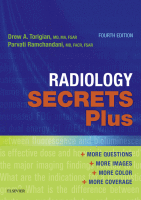Physical Address
304 North Cardinal St.
Dorchester Center, MA 02124

1 What are genitourinary fluoroscopic examinations? Genitourinary fluoroscopic examinations are studies that require “real-time” observation using fluoroscopy so that maximal information is obtained about the anatomy and function of the structure being studied. A radiographic iodinated contrast agent is injected…

1 What is a urogram? A urogram is an imaging study that is used to evaluate both the anatomy and physiology of the urinary tract. The major indications for urography are to evaluate patients with gross or microscopic hematuria, history…

1 Why is computed tomography (CT) commonly used initially for diagnostic purposes in patients with an acute abdomen or pelvis? Accurate and timely diagnosis of life-threatening disease involving the abdomen and pelvis is essential to decrease potential morbidity and mortality.…

1 What is the peritoneum? The peritoneum is the largest and most complexly arranged serous membrane in the body. It is closed in men and open to the ends of the fallopian tubes in women. The parietal layer lines the…

1 What are the general indications for computed tomography (CT) and magnetic resonance imaging (MRI) of the pancreas? CT and MRI are commonly used to assess the extent and severity of disease in patients suspected of having pancreatitis, to evaluate…

1 What is the normal CT and MRI appearance of the spleen? The normal spleen has homogeneous soft tissue attenuation on unenhanced CT, usually 5 to 10 HU less than liver, and appears slightly hypointense on T1-weighted images and hyperintense on…

1 What are the common indications for computed tomography (CT) and magnetic resonance imaging (MRI) of the liver, gallbladder, and biliary tree? The most common clinical indications include: Characterization of indeterminate hepatic lesions detected on prior cross-sectional imaging. Surveillance of…

1 What is shown in Figure 27-1 ? A topogram from a computed tomographic colonography (CTC), an examination tailored to evaluate for colorectal polyps and masses. 2 What is the adenoma-carcinoma sequence? The adenoma-carcinoma sequence refers to a series of…

1 Identify the parts of the colon (numbers 1 through 8) labeled in Figure 26-1 . For the answer, see the figure legend. 2 What are haustra? The longitudinal muscle layer of the colon is divided into three thick bands,…

1 What are the general indications for routine computed tomography (CT) and magnetic resonance imaging (MRI) of the upper gastrointestinal (GI) tract? General indications for routine abdominopelvic CT or MRI evaluation of the upper GI tract include: Assessment of patients…